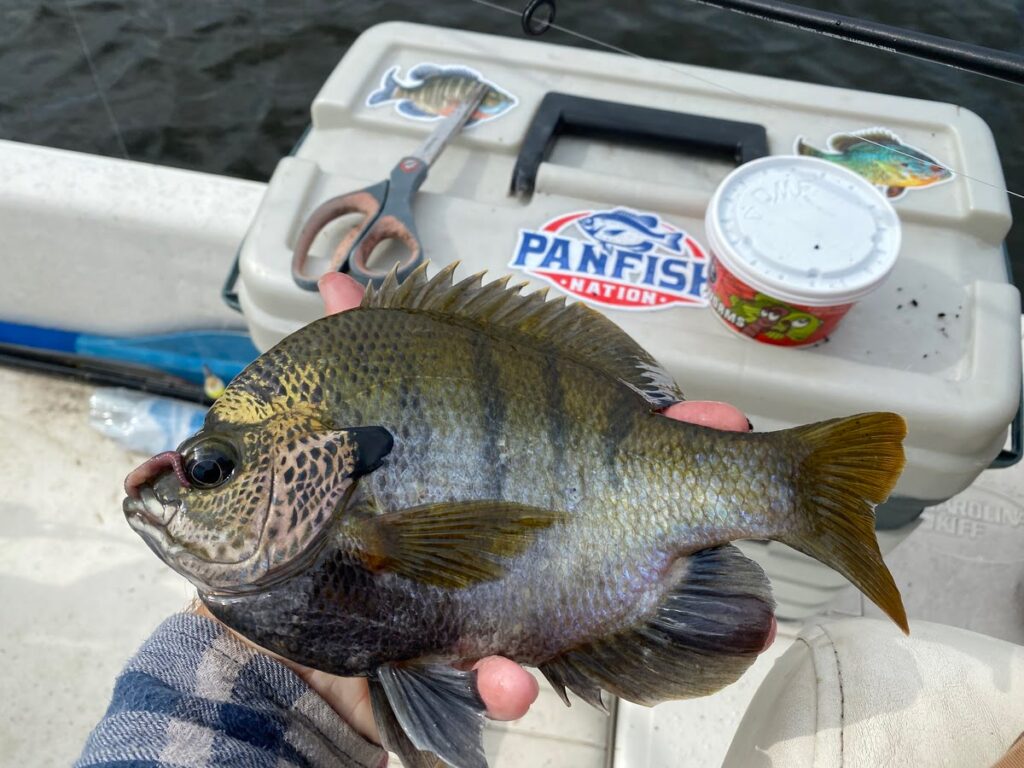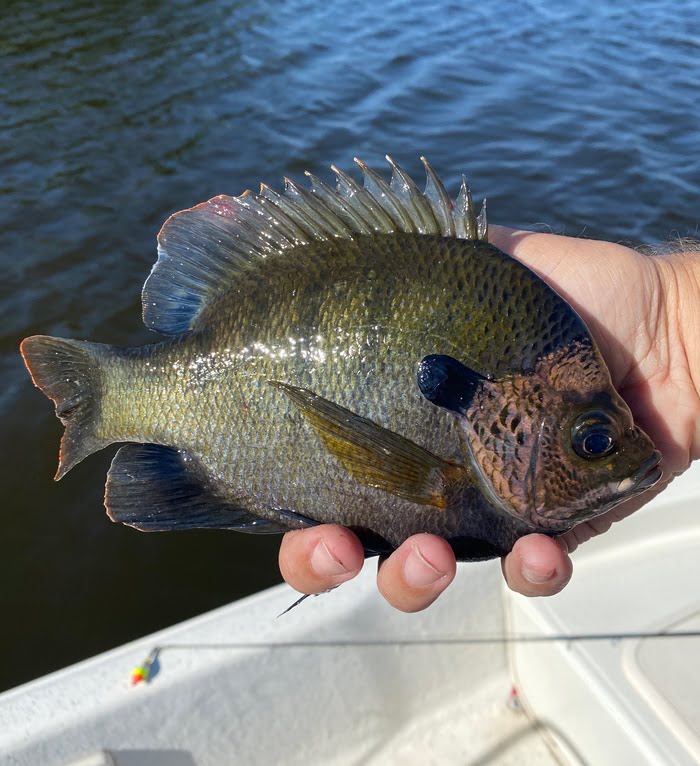The name is often whispered in hushed tones among anglers who’ve seen them. These legendary panfish are known as some of the biggest, meanest and hardest fighting sunfish on the planet.
But what exactly are coppernose bluegill?
Are they bluegill? A wholly different fish? Some kind of monstrous hybrid? The answer is none of these… but also all of these, depending on how you look at it!
As it turns out, even scientists aren’t in agreement on how exactly to classify these big baddies.
Though that might seem confusing, it’ll make more sense once we dive deeper into what makes these fish tick!
So let’s tie on our hooks and put on some sunscreen, because we’re going to tackle the most beastly of bluegills from the hot Floridian tropics.
Table of Contents
What Even Is a Coppernose Bluegill?
Coppernose bluegill (Lepomis macrochirus purpurescens) are, at their core, an extra beefy breed of bluegill.
They are similar in many ways to their standard bluegill brethren, but also different in that they grow faster, get a lot bigger, and exercise a higher degree of aggression.
In short, they’re bigger and meaner than other bluegill, which makes them an absolute blast to fish for!

Coppernoses are native only to the southeastern USA, and ‘true’ coppernose traits show up particularly strongly on the Florida Peninsula. Since their discovery, they’ve been widely stocked in other states such as Texas, California and more!
On a more scientific note, coppernose bluegill are considered a subspecies of the bluegill sunfish (Lepomis macrochirus), which means that they are a distinct subgroup, but not a different species.
Think of it like how poodles and labs are different, but both are still dogs! We’ll get more into the weeds with this further in the article if you’re interested.
How Can You Tell Common and Coppernose Bluegills Apart?
The easiest ‘tell’ for coppernoses is, as the name suggests, the copper! Adult coppernose bluegills have a large, bright metallic patch right above their eyes.
This isn’t technically the fish’s nose, but the name ‘copper-forehead’ doesn’t have quite the same ring to it, now does it?
Coppernose bluegill are also known to have a lighter colored, more bluish back, compared to the darker olive color on other bluegills. That being said, the copper spot is still the best way to know for sure what type of bluegill you’re hooking.
How Big can Coppernose Bluegills Get?
These behemoth bluegills can regularly reach up to a foot long, with the average individual being 6-8 inches long. Their growth rate is generally faster than other bluegill, and coppernoses can grow up to 3 inches per year under ideal conditions!
The International Game Fish Association (IGFA) does not have separate records for bluegill subspecies, so it’s hard to determine the biggest coppernose ever caught.
That being said, it should be noted that the biggest bluegill ever caught on record (a 4 ¾ pound monster out of Ketona Lake!!) was caught in Alabama, well within the range where coppernoses are known to reside.
While it can’t be confirmed, there’s a good chance that the coppernose tribe is responsible for producing the biggest bluegill on the planet, period. Talk about a fish with pedigree!
Are Coppernose Bluegills Good to Eat?
Coppernose bluegills are just as tasty as any other bluegill, with the added benefit that they’re usually larger, giving you more meat per fillet!
Bluegills are omnivores that eat a wide variety of different insects and invertebrates, so the exact taste of their meat may vary depending on what’s living in the water with them. That being said, as long as the water is clean you’re going to get a tasty treat!
There are few distinct words to describe the taste of bluegill, but it’s everything a good fish should be!
Mild, white, tender and and a little bit flaky, with a subtle sweet undertone. Truly the pinnacle of freshwater fare, as long as you catch enough of them for a meal.
Some of the largest coppernoses are known to sometimes eat small baitfish similarly to bass.

This is something all bluegills do once they hit a certain size, but coppernose bluegills reach these sizes on a more regular basis. This can lend a slightly fishy flavor to the biggest of the bunch.
The taste can still be good, but for those who are a bit pickier with fish, smaller individuals may be a safer bet. There are plenty of other reasons why the biggest fish aren’t the ideal choice to eat anyways, and you can read more about this topic here (link) if you’d like to know more!
Coppernoses in the Pond Stocking Business
Due to their aggression and faster growth rate, coppernose bluegill are seen as an ideal variety of bluegill to stock in a man-made pond.
They are great for first-time anglers since they will readily take live and artificial baits and fight with a vigor lacking in many other fish, even much bigger ones!
They’re known to be especially great for bass ponds, because bigger bluegills mean bigger food for largies to munch on.
Related: Why Does My Pond Only Have Small Bass?
Coppernoses are also known to eat pellet-based feed more readily than other bluegills, making them that much easier to grow.
Adding coppernoses to your pond can help you to grow both trophy bluegills and trophy bass!
How did Coppernose Bluegills Get So Different?
As covered earlier, coppernoses are a subspecies of bluegill, which puts them in a weird middle ground between them being bluegills and them not being bluegill.
They can successfully breed with other types of bluegills and produce fertile offspring that possess the characteristics of both, which points to them being the same species… but other sunfish can do this too!
It’s hard to differentiate when all members of the genus Lepomis are so closely related.
The reason that coppernose bluegill look and act different from their northern brethren comes down to a process called allopatry.
This is a process by which a population of organisms is separated into multiple groups due to geographic isolation, where the separated groups can’t breed with each other.
Over a long period of time, genetic changes can add up in both groups, and they can begin to show different traits between the regions.
So, it seems like, after a long while of being stuck by themselves in the deep south, the bluegills down there began to exhibit a faster metabolism and higher levels of aggression!
These adaptations may help them thrive in the warmer, more food-rich tropical climates they inhabit.
Allopatry, taken to the extreme, can eventually lead to organisms ‘splitting’ into two or more different species!
If coppernoses were left alone for many more thousands of years, there’s a chance that they would eventually become their own unique species… perhaps called the coppernose sunfish!
Human intervention has thoroughly mixed the gene pools of coppernose and other bluegill species by moving each around to other locations, slowing this divergence.
Conclusion
Regardless of their exact scientific status, it can’t be denied that coppernose bluegills are some of the most monstrous members of the sunfish family. If you get the chance, you should definitely try catching these beasts from the (south) east!
Whether you’re hooking these guys in their native range, or in a stocked pond somewhere far far away, these unique fish are sure to give you the fight of your life, and if you feel inclined, a meal to remember!
You May Also Like: Redbreast Sunfish vs Bluegill
If you haven’t guessed yet, I love fishing and everything about it!
To learn more about why I started Panfish Nation, visit the About page and follow along on Social Media:


Download a copy of my FREE Lure Color Selection Chart & Knot Guide!
Stay up to date with fishing reports, tackle reviews, industry news, and much more! We respect your privacy, unsubscribe at any time.
